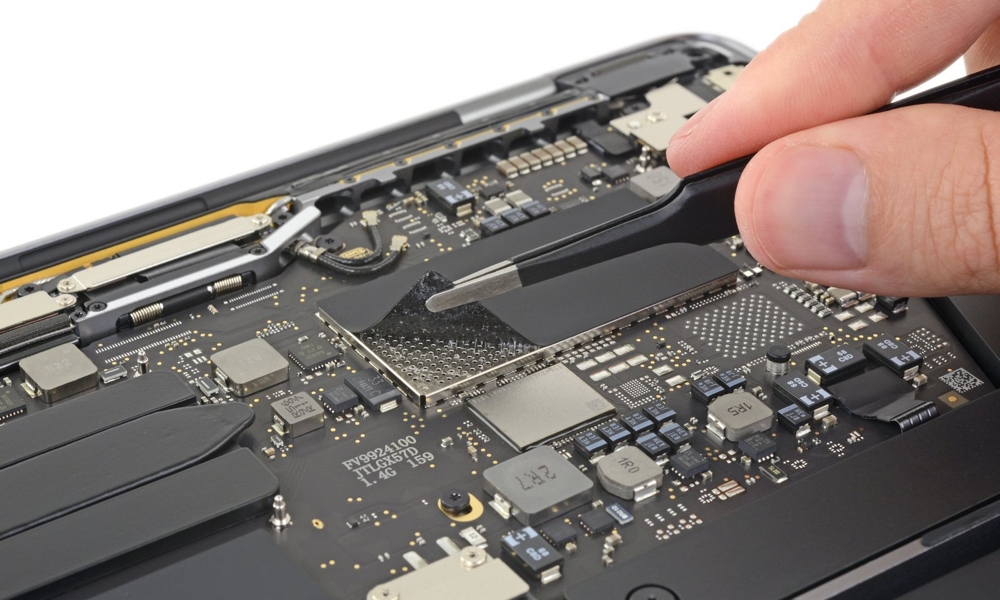iFixit Cracks Open Apple’s Newest 13-inch MacBook Pro
 Credit: iFixit
Credit: iFixit
Toggle Dark Mode
Apple surprised everybody earlier this week by not only refreshing the Retina MacBook Air — less than a year after its release last fall — but also bringing a big update to its entry-level Touch Bar-less MacBook Pro, bumping it up to an 8th-Gen Intel CPU and unifying it with the rest of the MacBook Pro family by adding a Touch Bar and Touch ID.
With the discontinuation of the 12-inch MacBook, this move leaves Apple’s MacBook family as the simplest and most straightforward lineup that we’ve seen in years, although despite the addition of the Touch Bar, Apple’s lowest-end MacBook Pro still may not be quite the same as its more expensive siblings.
For one, it still only has two Thunderbolt 3 ports, rather than four, which raises questions about what else may be different inside. Is it the same entry-level 2017 MacBook Pro with a Touch Bar crammed in, or is it a stripped-down version of the higher-end models?
Fortunately, we have iFixit, which has sought to answer this specific question by cracking open Apple’s latest MacBook Pro and taking a much deeper look at the internals.
The Outside
Looked at from the outside, the new MacBook Pro seems virtually identical to the rest of the family — it’s only the lack of two extra Thunderbolt 3 ports that gives it away as the lower-end model.
Of course, the specs also clock in much lower. A 1.4 GHz quad-core Intel Core i5 CPU is a far cry from the 2.0 GHz+ chips found in the mid-range MacBook Pros — although it still manages to outpace its 2.3 GHz dual-core predecessor by 83 percent, so don’t let the sub-2.0 GHz clock speeds fool you.
As iFixit notes, however, this MacBook may look familiar, but it’s a whole new model number — A2159, which answers the mystery of the MacBook that appeared in FCC filings last week.
iFIxit also adds that the headphone jack is “back” although we’re not sure what they’re referring to, as the prior models also all include a 3.5mm headphone jack as well, although the only other ports on this entry-level model are the aforementioned pair of Thunderbolt 3 ports, which iFixit suggests feels a bit “stingy” on a Pro-level machine.
Under the Hood
Interestingly, iFixit found that Apple has increased the battery capacity from 54.5 Wh to 58.2 Wh, which it speculates may be to drive the new Touch Bar while maintaining the same promised ten-hour battery life. It’s also slightly higher in capacity than the battery in the more expensive 13-inch model, although only by a very small margin (0.2 Wh).
It also looks like Apple shrunk a few things down to make room for the Touch Bar, with a slightly smaller heat sink and speaker. Whether this will result in heating problems is uncertain, but its worth noting that with four cores, there’s no reason to think that this new MacBook Pro will run any cooler than its predecessor.
Another change that’s not surprising but perhaps a bit disappointing is that the SSD is now soldered directly onto the logic board. This wasn’t the case with the 2017 model, but it’s in line with what Apple has been doing with the rest of its MacBook Pros, so while it means that the SSD won’t be upgradeable, as least Apple is being consistent here.
Despite having only two Thunderbolt 3 ports, the new 2019 MacBook Pro does gain the modular design of its more expensive counterparts, which is a nice upgrade from the 2017 model that should at least make it easier to replace a broken port. The headphone jack is also similarly modular.
The Keyboard
As we previously reported, the new MacBook Pro is using the same third-generation butterfly keyboard as the rest of the 2019 MacBook Pro family, which is basically just a slightly tweaked variation on the keyboard used in last year’s models. iFixit refers to this as a “generation 3.5” design, and confirms that this is in fact the case.
Apple has headed off any complaints at the pass, however, by proactively announcing that ALL of the new MacBooks released this year will be eligible for free keyboard repairs for up to four years, so potential buyers have less reason to be concerned. As we noted earlier, and iFixit suggests also, it’s really unknown whether Apple actually expects these keyboard to fail like prior generations did, or whether it’s just trying to assuage potential customers and avoid any more bad PR fallout from the long-running debacle with its butterfly keyboards.
The Verdict
For all intents and purposes, this is basically a scaled down design of the rest of the 2019 MacBook Pro family, which is a good thing in that it means that Apple hasn’t just patched up the 2017 model, but really has brought it up to the same level as the rest of its MacBook Pros. For better or worse, this as least means that Apple’s entire MacBook Pro lineup is consistent, and while users will lose the ability to upgrade the SSD (so make sure you buy the storage you need right away), it should be a lot easier to replace the ports and trackpad.






